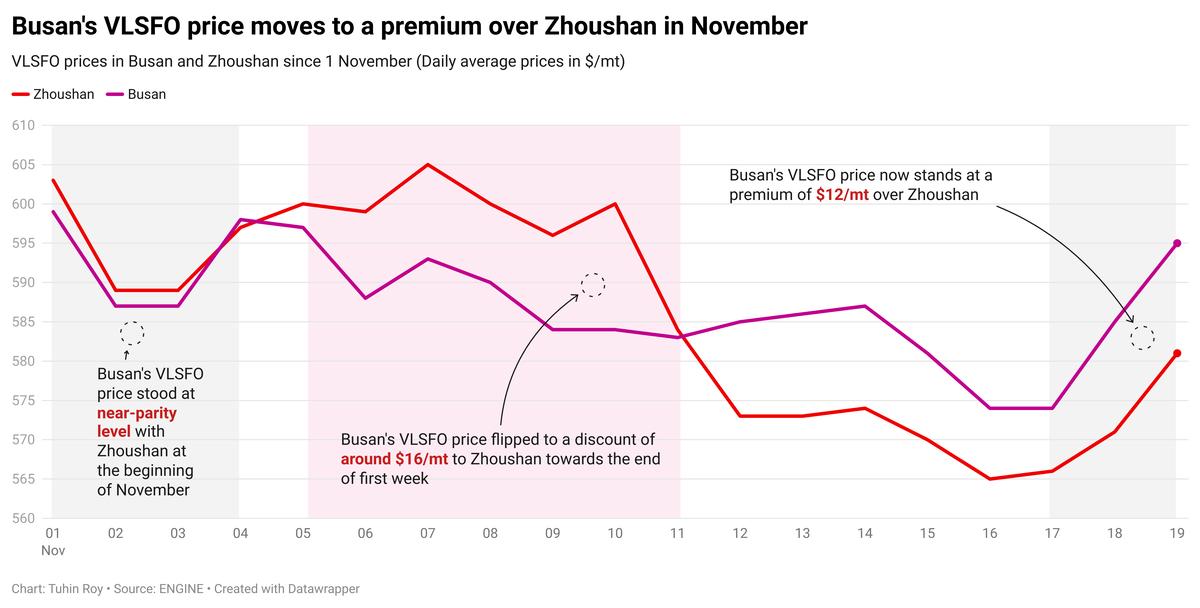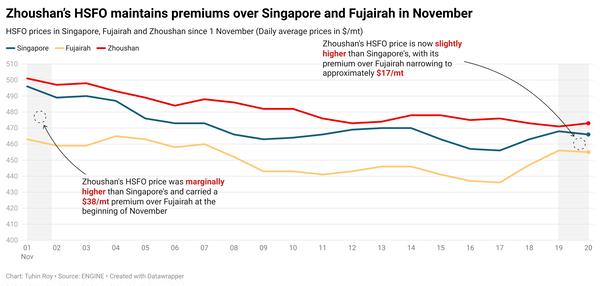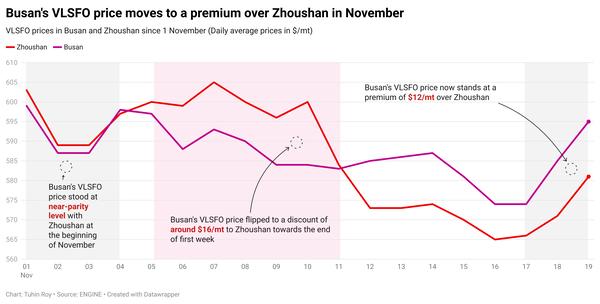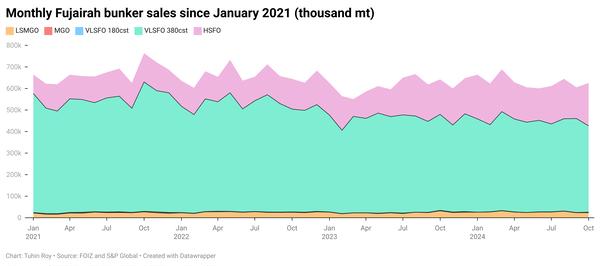East of Suez Market Update 19 Nov 2024
Most prices in East of Suez ports have tracked Brent’s upward movement, and supply of all grades remains normal in China’s Zhoushan.

Changes on the day, to 17.00 SGT (09.00 GMT) today:
- VLSFO prices up in Zhoushan ($13/mt), Fujairah ($5/mt) and Singapore ($3/mt)
- LSMGO prices up in Fujairah ($33/mt), Singapore ($19/mt) and Zhoushan ($11/mt)
- HSFO prices up in Fujairah ($14/mt) and Singapore ($9/mt), and down in Zhoushan ($8/mt)
Zhoushan’s VLSFO price has risen by $13/mt, marking the sharpest increase among the three major Asian bunker hubs. A higher-priced VLSFO stem fixed in Zhoushan has contributed to this upward movement, pushing its price from near parity to a $10/mt premium over Singapore. Additionally, Zhoushan’s VLSFO premium over Fujairah has widened from $13/mt, to $21/mt now.
Despite low demand, bunker fuel availability in Zhoushan remains steady, with suppliers advising lead times of 5–7 days for VLSFO and 3–5 days for LSMGO and HSFO.
In South Korea, Busan’s VLSFO price is now $12/mt higher than Zhoushan’s benchmark.
In southern South Korean ports, lead times for VLSFO and LSMGO have increased from 2–7 days last week, to 3–9 days now, reflecting tighter supply.
Availability of these grades has tightened in western ports and deliveries are subject to inquiries. Last week, lead times in western ports were 2–7 days.
Conversely, HSFO supply in South Korea has improved, with most suppliers recommending a lead time of around seven days for this grade across all ports, compared to last week when availability was inquiry-dependent.
Bunker operations at Ulsan, Onsan, Busan and Yeosu ports are expected to face intermittent disruptions due to potential bad weather conditions during 22-24 November. Bunkering interruptions are also anticipated at Daesan and Taean ports during 21-23 November.
Brent
The front-month ICE Brent contract has moved $1.88/bbl higher on the day, to trade at $72.87/bbl at 17.00 SGT (09.00 GMT).
Upward pressure:
The sudden escalation of the Russia-Ukraine conflict has pushed oil prices higher.
Brent’s price surged after Washington approved Ukraine’s use of long-range missiles against Russia, ramping up tensions between the two warring nations, according to media reports.
“[Brent] crude oil roared to life, surging nearly 3%, as geopolitical tensions reignited with the US greenlighting Ukraine’s use of long-range missiles against Russia,” SPI Asset Management’s managing partner Stephen Innes said.
Meanwhile, oil production of about 755,000 b/d in Norway’s Johan Sverdrup field has been cut due to a power outage, Reuters reports. This news has also supported oil prices.
“A halt of production at the 755k b/d [755,000 b/d] Johan Sverdrup field in Norway due to a power outage… provided further upside [to oil],” two analysts from ING Bank said.
Downward pressure:
Demand growth concerns simmering in China, the world's second-largest oil consumer, have continued to put some downward pressure on Brent’s price.
Chinese oil consumption in October dropped by 5.4% month-on-month, with refiners processing about 59.54 million mt of crude oil last month, according to data from the National Bureau of Statistics (NBS).
“Chinese demand concerns continue to overshadow global tight supply and optimistic predictions for the upcoming Thanksgiving travel expectations,” Price Futures Group’s senior market analyst Phil Flynn said.
Moreover, recent economic data from China has raised concerns among market participants about the inefficacy of Beijing's latest stimulus package. Earlier this month, China unveiled a 10 trillion yuan ($1.40 trillion) stimulus package to support economic growth in the country.
China's October industrial output increased 5.3% year-on-year, slipping from a 5.4% growth recorded in September, the NBS reported.
Weakness in industrial output indicates weak economic health, as well as a contraction in the manufacturing sector, which includes production, inventory levels, etc. It highlights demand growth concerns, ultimately weighing down on prices of commodities like oil.
By Tuhin Roy and Aparupa Mazumder
Please get in touch with comments or additional info to news@engine.online

Contact our Experts
With 50+ traders in 12 offices around the world, our team is available 24/7 to support you in your energy procurement needs.





